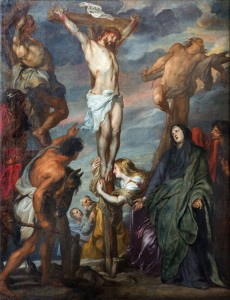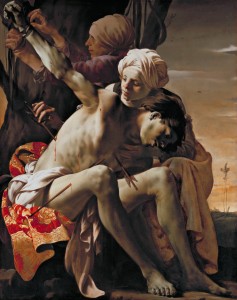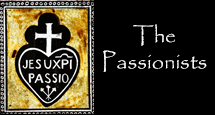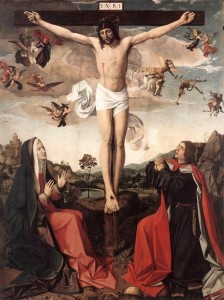Mary at Calvary
by Paul Zilonka, C.P.
In the parish church where I grew up, the massive main altar from the 1950s is surmounted by a life-size sculpture of the crucified Jesus raised slightly over the statues of Mary his mother and a beardless man whom we usually think of as one of the Twelve disciples, specifically John the brother of James and son of Zebedee. This traditional artistic representation of Mary at Calvary is based solely on the scene proper to the Gospel of John 19:25-27 which reads: “Standing by the cross of Jesus were his mother and his mother’s sister, Mary the wife of Clopas, and Mary Magdala. When Jesus saw his mother and the disciple there whom he loved, he said to his mother, ‘Woman, behold your son.’ Then he said to the disciple, ‘Son behold your mother.’ And from that hour the disciple took her into his home.”
This Calvary scene in John varies significantly from the same scene in the Synoptic Gospels in two ways. First, the Gospel of John mentions the presence of a male disciple “whom Jesus loved” and the mother of Jesus on Calvary. Secondly, the scene portrays them close enough to the cross to hear Jesus address them. Despite this unique attention to these two persons, the citation in John is verbally linked with the Synoptic Gospels when it mentions several other women along with the mother of Jesus, namely, “his mother’s sister, Mary the wife of Clopas, and Mary Magdalene.” It seems certain that these are three distinct women since it is not likely that “his mother’s sister” would be identical to “Mary of Clopas.” Otherwise that woman would have had the same name as Mary, Jesus’ mother. (John 19:25).
When our loved ones pass from this life, we want to know who was with them in those final moments. For that reason, it makes sense that we are curious about which of Jesus’ friends or relatives might have been with him at the moment of his death on “the place called the Skull” (Luke 23:33). The comparison of the names of these women in all four Gospels offers some help, especially since Mary Magdalene is the only name found in all four Gospels.
The Synoptic Gospels speak in various ways of those who “stood at a distance” (Luke 23:49). These include women who had followed Jesus from Galilee “among whom were Mary Magdalene, and Mary the mother of James and Joseph, and the mother of the sons of Zebedee (Matt 27:56). Mark 15:40-41 mentions Mary Magdalene, Mary the mother of James the younger and of Joses, and Salome. Despite the differences, Mark and Matthew appear to agree on the same three or four women, depending on whether Salome is the name of the wife of Zebedee. We should also note the similarity with the names of the women at the empty tomb on the third day. In Matthew 28:1 we read, “Mary Magdalene and the other Mary went to see the tomb.” Mark 16:1 closely echoes the group on Calvary when it says, “When the sabbath was over, Mary Magdalene, the mother of James, and Salome bought spices that they might go and anoint him.” Luke 24:10 says, “The women were Mary Magdalene, Joanna and Mary the mother of James.”
 This common Synoptic tradition of “three women,” despite the different names, basically links them together as witnesses of the death, the location of the tomb, and the discovery that it was empty on the morning after the sabbath. The fusing of this Synoptic tradition of “three women” with the claim of John 19:25 that the mother of Jesus and beloved disciple were also present near the cross appears to have an artificial quality to some scholars. For instance, Jesus does not address those other women named as “standing by the cross” in any distinctive way.
This common Synoptic tradition of “three women,” despite the different names, basically links them together as witnesses of the death, the location of the tomb, and the discovery that it was empty on the morning after the sabbath. The fusing of this Synoptic tradition of “three women” with the claim of John 19:25 that the mother of Jesus and beloved disciple were also present near the cross appears to have an artificial quality to some scholars. For instance, Jesus does not address those other women named as “standing by the cross” in any distinctive way.
Because we might interpret this scene in terms of what we might like for our mother if we were near death, it is understandable why some people find in John solely an expression of filial devotion from the lips of Jesus. Indeed, this quite natural and spontaneous understanding has been part of the history of this text’s interpretation for centuries. However, like so many scenes in the Gospels, what seems quite clear at first glance, may not fully explain the text. This is particularly true of the Gospel of John, which is rich in symbolism even in what appear to be uncomplicated historical scenes.
The general principle of contemporary critical interpretation of any book of the Bible is to interpret a particular text in the light of the whole book. When we look for some possible connections between this unique presence of “the mother of Jesus” and the “disciple whom he loved” at the cross and in other settings in the Gospel of John, we discover strong echoes in the episode at Cana in Galilee (2:1-11), which marked the first public action of Jesus in this Gospel.
That scene seems to be a simple historical account of a wedding feast in which Mary intercedes with Jesus to spare the groom some embarrassment when the supply of wine has run out. Jesus initially balks at intervening for this merely social reason, speaking instead of “my hour,” whose meaning is not immediately evident. “Woman, how does your concern affect me? My hour has not yet come” (John 2:4). But the mother of Jesus seems to ignore his hesitation by ordering the servants to follow his directions. Even though Jesus follows his mother’s wishes, the evangelist makes clear at the end of the scene that this extraordinary event is more than a friendly gesture to spare momentary embarrassment. “Jesus did this, as the first of his signs in Cana in Galilee and so revealed his glory, and his disciples began to believe in him” (John 2:11).
The distinctive “mother of Jesus-beloved disciple” address by Jesus from the cross echoes the Cana story in three ways. At Cana, when “the mother of Jesus” intercedes with Jesus to help the wedding couple, Jesus addresses his mother as “Woman,” which would be perfectly acceptable for a man speaking to a woman but not a son to a mother. In this regard, John’s presentation of Jesus’ relationship to his relatives has some similarity to the way the Synoptics generally distance him from his family of origin during his ministry. For instance, the “brothers” who are mentioned as being with his mother and his disciples in John 2:11 are judged in 7:3-7 as not having believed in him.
 When Jesus hesitates to intervene with a solution to the lack of wine, he refers to “my hour” as still in the future. Though he then accedes to his mother’s wish to help in the present instance, this reference to “my hour” really points forward in this Gospel to the hour of the passion, which will also be an hour of glory (John 7:30; 8:20; 12:23, 27; 13:1; 17:1). That hour has now arrived on Calvary.
When Jesus hesitates to intervene with a solution to the lack of wine, he refers to “my hour” as still in the future. Though he then accedes to his mother’s wish to help in the present instance, this reference to “my hour” really points forward in this Gospel to the hour of the passion, which will also be an hour of glory (John 7:30; 8:20; 12:23, 27; 13:1; 17:1). That hour has now arrived on Calvary.
Finally, it is obvious from Jesus’ hesitation about the wine at Cana that he and his mother had no common concern there, but now they do. On Calvary, his words reveal a role that establishes a new intimate relationship between his mother and the one “whom Jesus loved.” This person emerges in the second half of the Gospel of John as one who represents the “ideal” disciple who “was reclining at Jesus’ side” (13:23), followed Jesus into the courtyard of the house of Caiaphas (18:15-16), and was the only male disciple “standing by the cross of Jesus” (19:25). The whole atmosphere of this exchange between Jesus and his mother and the disciple whom he loved is a witness to something that will go forward after Jesus has died. This is the last willed act of Jesus, an act of empowerment. It both reveals and establishes a new relationship, which all future disciples will share with those who once knew Jesus and all, like ourselves, who have come to know him through the Gospel of John.
Bibliography
Brown, Raymond E, The Death of the Messiah. 2 vols. Anchor Bible Reference Library. NY: Doubleday, 1994.
Moloney, Anthony, John. Sacra Pagina, Vol 4. Collegeville MN: Liturgical press, 19xx
O’Day, Gail, “The Gospel of John: Introduction, Commentary, Reflections.” In The New Interpreter’s Bible Commentary, Nashville: Abingdon, 1995. 9. 491-865.

